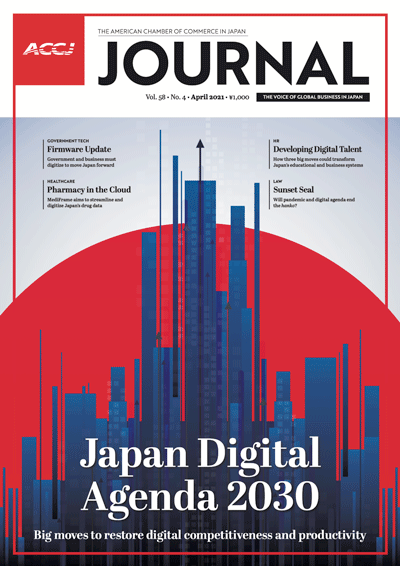Sunset Seal
WILL PANDEMIC AND DIGITAL AGENDA END THE HANKO?
By Julian Ryall
In late 2010, there was an undeniable sense of dismay hanging over Japan as China became the second-largest economy in the world. It had long been recognized as inevitable that Japan would slip to third place, but it was still cause for some national hand-wringing. A little over a decade later, Japan is at real risk of falling even further in the global economic rankings, in part because the nation has failed to fully embrace technology and digitalization.
Japan is, in so many ways, stunningly technological. This is the land of the shinkansen and supercomputers, of spacecraft, cutting-edge medical devices, impressive software, and any number of home-use gadgets that boggle the mind. Which makes it all the more contradictory that this society has hung on so grimly to a handful of archaic approaches to doing business, chief among them the hanko (personal seal) and the fax machine.
And while the coronavirus pandemic has been a tragedy for millions of people and a disaster for far too many businesses, the one silver lining in Japan might be that it has hastened efforts to wean the nation off long-obsolete tools and to replace them with up-to-date ones, such as the electronic signature.
Government Moves
In the early phases of the pandemic, the nation’s bureaucracy—never one to adopt new concepts easily or quickly—accepted that hanko are no longer conducive to a modern economy. In late April 2020, then-Prime Minister Shinzo Abe ordered ministries to draft new laws to get around the nation’s archaic dependence on seals.
Catherine O’Connell
Founder Catherine O'Connell Law
Co-chair, Legal Services & IP Committee
The order came as many companies ignored government requests to encourage staff to work from home and avoid public transportation to help stop the virus from spreading. Senior officials needed to be seated at their desks just so they could apply hanko to company documents. Without that bit of red ink, entire businesses would have ground to a halt.
The campaign was given a timely boost in October, when Taro Kono—newly appointed as the minister tasked with hacking through Japan’s legendary red tape and reducing bureaucratic and corporate inefficiency—declared war on the hanko and fax machine.
Within a week of his appointment, Kono had ordered all national government offices to halt the practice of requiring hanko on all official documents, with that personal touch only required for extremely important or sensitive paperwork.
In a letter distributed by the Cabinet Office, Kono instructed every ministry to answer whether they intended to comply with his directive, whether they would “consider” doing so, or if they intended to continue business as usual. Those that decided they were going to stick with the tried-and-trusted hanko were required to provide an explanation as to the reason before the end of September.
“Why do we need to print things out on paper?” Kono asked at a press conference outlining the campaign. “In many cases, it is simply because the hanko is required. So, if we can put a stop to that culture, then it will naturally do away with the need for printouts and faxes.”
Aiko Okada
Vice-chair, Legal Services and IP Committee
Winds of Change
Where the nation’s bureaucracy leads—however reluctantly—the business world follows. And that change in attitudes has enabled lawyer Catherine O’Connell to breathe a sigh of relief.
“So much time is taken up with my corporate clients having contracts executed by hand, with the seal held by a person at the office,” said O’Connell, founder of Tokyo-based Catherine O’Connell Law and co-chair of the American Chamber of Commerce in Japan (ACCJ) Legal Services and IP Committee.
“Generally, it is not permitted for a person to take the company hanko out of the office, and even beyond the four walls of the legal department in some cases. This has caused such a problem over the past 12 months for many companies, because they need extra approvals to be put in place—also, ironically, requiring a hanko to be approved—and added security for a hanko to be kept at home,” she told The ACCJ Journal.
The Japanese government’s strides in creating a hanko-free environment “are certainly welcome in my field of commercial law,” O’Connell said. “Electronic signatures have gone a long way towards helping the situation for English-language contracts, although the digital hanko for Japanese-language contracts has still to take off as a viable option.
The need to apply hanko to documents has created obstacles to digital transformation.
“I would really like to see the government work towards a digital hanko with secure authentication mechanisms that can be used electronically for submitting documents,” she said, pointing out that a domestic company has already developed the digital hanko. But companies she has spoken with say they haven’t taken it up largely as a matter of custom, as it is not widely used by others. Legislation permitting the hanko to be totally abandoned has yet to be amended.
Slow but Steady
ACCJ Legal Services and IP Committee Vice-Chair Aiko Okada, who works in a local government, says the old-fashioned way of conducting administration is still considered the only way to serve all residents equally. “Even today, when many things are at our fingertips thanks to the internet and smartphones, the government is still reluctant to change the status quo,” she explained.
But change, she said, is coming. “Gunma Prefecture, like other government agencies, required hanko for many procedures; but as soon as Kono made his announcement, many of them were revised and 97 percent of hanko requirements had been removed by the end of fiscal 2020.”
Mihoko Nishijima
Vice-chair, Secure Digital Infrastructure Committee
Mihoko Nishijima, vice-chair of the ACCJ Secure Digital Infrastructure Committee, argues that since announcing its decision, the government has moved quite swiftly in terms of regulatory reform. But attitudes among many users may take longer to change.
Already, the need for a hanko has been abolished in 5,198 of the nation’s 14,992 administrative procedures, she said, and ministerial ordinance revision as well as legal reforms are being studied.
“The government is committed to promoting the use of electronic signatures as soon as procedures are in place to ensure the integrity and authenticity of documents,” she said. “Other details on the use of cloud-based e-signatures are being incorporated into Japan’s Act on Electronic Signatures and Certification Business, so the government does see this is a user-friendly technology for its citizens.”
Seize the Moment
For Jim Weisser, change cannot come soon enough. A serial technology entrepreneur since arriving in Japan in 1993, Weisser set up SignTime K.K. in September 2020 to develop electronic signature services. And he says that the challenges brought about by the pandemic have really served to focus leaders’ attention on the parts that are slowing down their operations. For many, the hanko is an obvious place to start.
Jim Weisser
Co-founder & CEO, SignTime K.K.
Co-chair, Digital Trade Committee
“It’s not just an issue of convenience; one thing that these folks are realizing is how much risk they have centralized in their offices in the shape of their hanko,” said Weisser, who is co-chair of the ACCJ Digital Trade Committee. “Most companies understand that a physical approval process based on moving bits of paper around has problems, but they never did anything about it. This is their opportunity.”
The concept is largely being driven from the inside out, he said. Sales employees are enthusiastic about electronic signatures as they no longer need to print out their paperwork, put a hanko on each page, scan it, and then send it. Electronic signatures “cut their turnaround times dramatically,” Weisser said.
Next on his list to convince are human resources departments. Once they are on board, Weisser believes what is currently a “creeping process” will take off.
At present, Weisser estimates that between one and two percent of all white-collar workers in Japan are using electronic signatures. In the United States, that figure is five times higher. Yet he remains optimistic.
Weisser contributed to a paper by the chamber’s Secure Digital Infrastructure Committee that concludes an “obvious first step” would be legislation that allows any digital signature to have the same legal standing as a fax, considering that any digitally signed document is going to have a much more material audit trail than a paper fax with a hanko or signature.
“After that, there are a number of additional methods which may be appropriate, including using blockchain, providing photographs of the signatory, or doing an associated video recording of any statutory language that is required, which could also be attached to an audit trail,” the report concluded.
The key, Weisser adds, will be to make the system that is adopted straightforward and user friendly. Overengineering a solution will only serve to limit market adoption. “It’s coming,” he said. “The changes may be incremental at present, but we will get there.”
THE JOURNAL
Vol. 58 Issue 4
A flagship publication of The American Chamber of Commerce in Japan (ACCJ), The ACCJ Journal is a business magazine with a 58-year history.
Christopher Bryan Jones, Publisher & Editor







